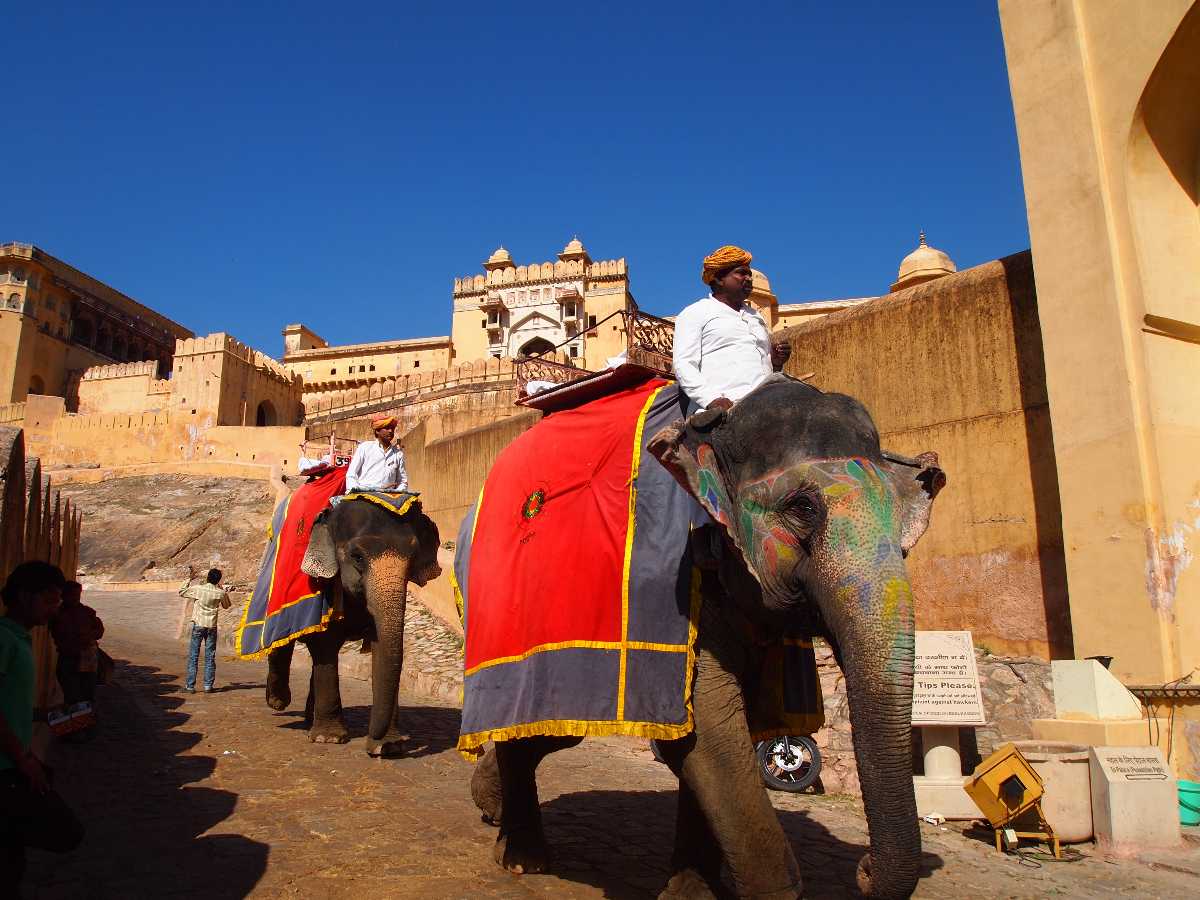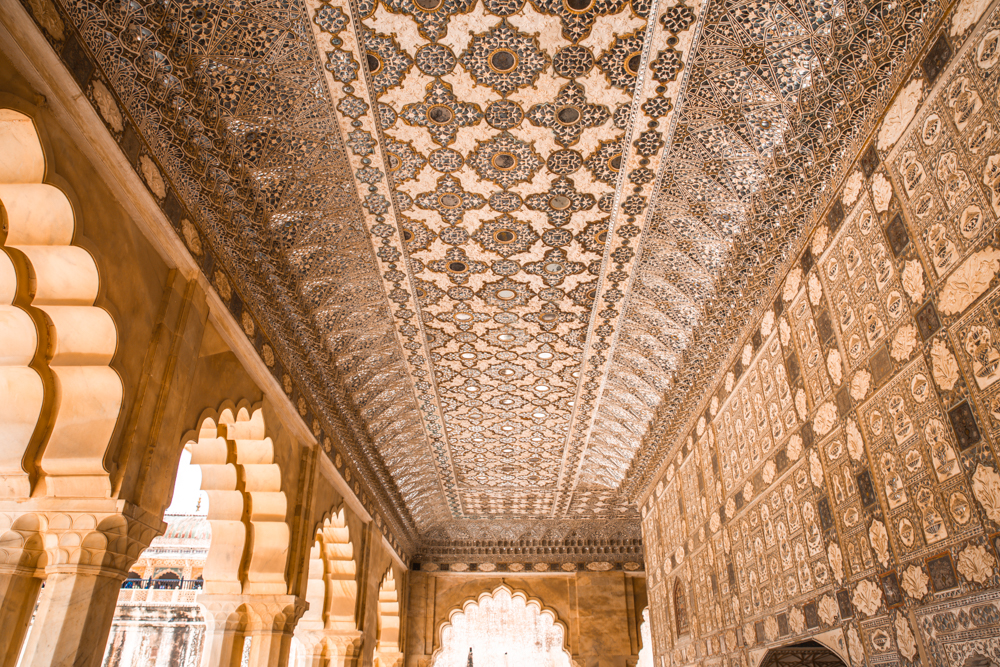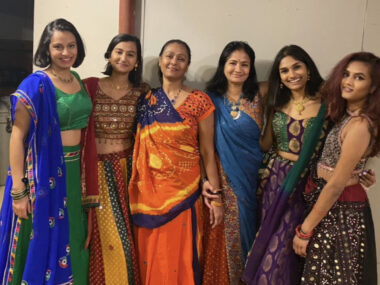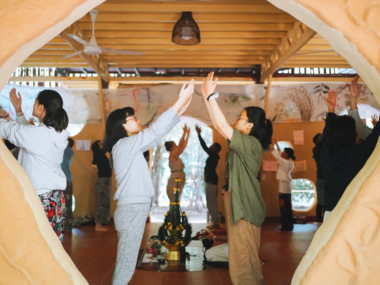Table of Contents
Like probably a billion other girls on this planet, I’ve always carried a secret princess inside me. You know the one with naturally long lashes and flawless skin, who never woke up with a pimple hours before an important date?
But somewhere between teenage dreams and adult responsibilities, that inner princess went into hibernation.
Until I found myself standing on a dusty road in the Aravalli hills, craning my neck to stare up at the red hues of Amber Fort.

Honey-gold ramparts crown a hillside above Maota Lake.
At this precise moment, I swear I felt her stirring, stretching, yawning awake. And suddenly, I wasn’t just another tourist with her nose buried in Google Maps, trying to get the best out of the Pink City.
I was the Queen whose kingdom—aka Amber Fort—sits about 11 kilometers northeast of Jaipur, a thirty-minute ride that feels like traveling back through centuries.
The Palace at Amer Fort
Built in 1592 by Raja Man Singh, this red sandstone and marble masterpiece originally served as the capital before Jaipur stole the spotlight.
And to get there, I had the option to hop on an auto-rickshaw, cab, or bus. Instead, I chose something infinitely more…Queen-appropriate.
You see, after finishing half the journey by rickshaw, I was told I could ride an actual elephant for the final ascent.

Ornate elephants carry riders through Jaipur’s fortress gates.
So maybe my elephant moved at roughly the speed of molasses mixed with bureaucratic paperwork, and yes, I was slightly terrified I’d tumble off and become a cautionary tale for future tourists ever exploring Jaipur. But damn if I wasn’t making an entrance worthy of a Maharani.
The other tourists in their air-conditioned vehicles could maintain their comfort. Thank you very much!
After dismounting far less gracefully than I’d hoped, I chose my companion for the four or so hours amongst the gazillions.
Because let’s be honest, wandering through a 400-year-old fort without context is like jumping into a movie halfway through and pretending you understand why everyone’s crying at the little girl’s song.
Pro tip: This is where you need to channel your inner Henry Kissinger. If you’re not careful, these government-approved wizards who know every nook and cranny might charm their way into your wallet, leaving it gasping for air.
The first stop was Jaleb Chowk, this massive courtyard where you can gaze out over Maota Lake and pretend you’re surveying your domain. The guide went on, drowning in details about how centuries ago, this very spot was where the military drilled, horses’ hooves clattered against stone, and soldiers prepared to buzz off the invaders.
Standing there, I could almost hear the echoes in the air, along with occasional yelps of annoyed toddlers, or couples arguing about the best selfie angle.
Mr. Wizard pointed toward the closed-off, massive wooden doors of the Shila Devi Temple and explained that to explore further, I’d need a ticket.
One hundred rupees for Indians, five hundred for foreigners. And twenty-five rupees if you still endure the torments of exams and lectures!
The Diwan-i-Aam (Hall of Public Audience) is basically a vast pillared hall where common people once gathered, hoping for an audience with their maharaja. Standing under those arches, I imagined the weight of hundreds of eyes watching as the king dispensed justice from his throne.
Then we reached the Ganesh Pol. Its frescoes are still vibrant after centuries. This gateway led us to the private palaces—basically the VIP section of royal life. Every wall and texture would literally spellbind you in awed silence.
But it’d be Diwan-i-Khas or the Sheesh Mahal that would steal your breath away.

Glittering mirror mosaics and arches reflect soft candlelight.
I’m not being dramatic when I say the world literally stopped for a second. Or maybe I stopped. Either way, time became irrelevant because I was standing inside what looked like someone had captured the entire night sky and decided to redecorate their room with it.
Thousands of convex mirrors embedded in the walls and ceiling created what could only be described as a “glittering jewel box in flickering candlelight” (if that jewel box had been designed by someone who clearly never heard the phrase “less is more.”)
Mystic Magic of the Mirror Palace at Amer Fort
The guide lit his phone’s flashlight, and suddenly I was standing inside a universe of reflected stars that put every planetarium show to shame.
According to a local lore, one of the queens longed to sleep under a blanket of stars, but as royal women weren’t permitted to step outside at night, the king commissioned a palace that could bring the sky indoors. The result was breathtaking. A hall where thousands of tiny, hand-cut mirrors, locally called Kanch ki Barfi, were embedded into walls and ceilings alongside colored glass, floral motifs, and precious stones.
These mirrors were so perfectly placed that even a single candle’s glow could transform the entire space into a shimmering galaxy.
And magical those twenty minutes were. The romantic in me was dying.
“Can you imagine? Someone loving you enough to custom build you the sky?”
But that’s exactly where the fairy tale… complicates itself.
Because this green-flag king had twelve wives.
I know. I KNOW.
Each queen represented a different zodiac sign—Raja Man Singh believed aligning his marital life with astrology would bring him fortune in war. And it worked! History says he never lost a single battle.
But the victories were the least of my concerns.
“How,” I asked, “did he manage twelve wives?”
The answer was the Fort itself.
Raja Man Singh designed the Zenana, the royal women’s quarters, like a labyrinth of peace treaties. Each queen had her own private chamber, with its own kitchen, dressing room, bath area, and attendants.
There were secret passageways from the king’s private chamber to each wife’s room, allowing him to visit discreetly without the others knowing.
As per the rule, the queens were forbidden from interacting with each other, a strategy that kept jealousy and politics at bay while maintaining the illusion of harmony.
As I wandered through the Zenana, my imagination slipped into overdrive. I traced my fingers along the walls, imagining giggles and gossip between royal ladies. Each trying to know with whom the Maharaj was!
As the guide explained, I tried living the festivals in the walls through the queen’s eyes—Basant Panchami, Holi, Rakhi, Diwali—the courtyards exploding with colors and music, laughter spilling from balconies, and a hundred bangles and ankles chiming in happiness and excitement.
And yet, beneath all that splendor, I couldn’t shake off the thought.
What was it like to be one of twelve?
Planning Your Own Royal Awakening at Amer Fort
If you’re ready to wake up your own inner royalty, timing is everything. Visit between October and March when the weather won’t melt you into a puddle of regret and sunscreen. The fort is open from 9:30 AM to 5:00 PM, and I recommend going in the morning (around 9 AM) for perfect light and fewer crowds competing for the best mirror selfies.
Plan for at least three to four hours. Trust me, you’ll want to sit in every courtyard, run your hands along every carved wall, and take approximately 847 photos in the Sheesh Mahal.
If you’re feeling extra royal, there are evening light and sound shows too.
The elephant rides (when available) cost ₹1200 for two people and operate early in the morning, so arrive early if you want that full royal entrance experience.
Please note that the elephants here are well cared for (as I was told), and the tradition runs deep—but it’s also okay to skip the ride if you’re feeling conflicted. History and ethics don’t always walk in step, and sometimes the most regal thing you can do is simply observe.
From various spots in the fort, you’ll catch glimpses of the Aravalli hills rolling into the distance, creating backdrops that’ll make your Instagram followers weep with envy and probably ask if you hired a professional photographer.
The Queen I Found at Amer Fort
As the afternoon sun began its descent and I made my way back down the hill, I felt fundamentally changed. Amber Fort hadn’t just shown me incredible architecture or taught me fascinating history. It had allowed me to reflect, reimagine, and relax.
That little girl who believed in fairy tales was still there, but she’d grown up and gotten complicated. Now she knew that the most important prince charming who could sweep her off her feet was her own self. And it’d be enough!
Why does the Mirror Palace feel almost otherworldly?
It was built for longing, not luxury. Every mirror was placed to turn one small flame into a galaxy of light. Standing there feels less like sightseeing and more like stepping inside a dream someone once whispered into stone.
What surprised you most about Amer Fort?
How personal it feels. Behind all the grandeur are stories of love, rivalry, and imagination. You expect cold marble and history lessons but find warmth, humor, and echoes of real lives instead.
Why is Amer Fort also called Amber Fort?
Both names refer to the same place. “Amber” is the older Anglicized version of “Amer,” derived from the local name of the town. You’ll still hear both used interchangeably by locals, guides, and maps.
Why do travelers connect so deeply with this fort?
Because it mirrors emotion more than history. People see themselves in its reflections, in the glitter and the cracks, in the stories of longing and strength that have outlasted centuries.







